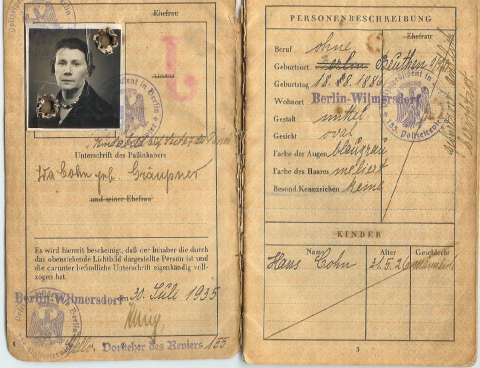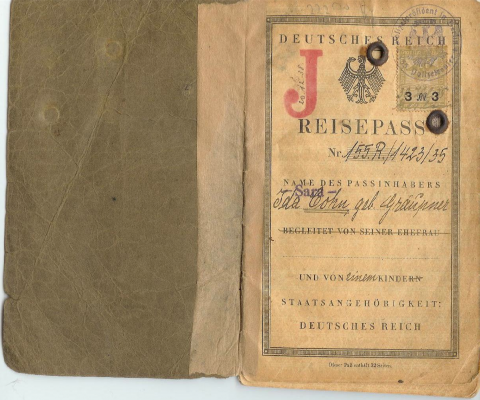
By Becki Cohn-Vargas
“These [congressional] proposals [restricting the entry of] Syrian refugees) are motivated by fear, not by the facts, and they fly in the face of our country’s proud tradition of admitting refugees from every corner of the globe and every faith background. We have always been a generous nation, and we have in place a rigorous process for refugee resettlement that balances our generosity with our need for security. It works, and it should not be stopped or paused.”
-Former Secretary of State Madeleine Albright
My grandmother’s German passport has a big red “J” in the corner, and her passport name includes the name “Sarah,” which was added so that authorities would know that she was Jewish. She was able to flee Germany with only the clothes on her back and my young father in tow. They were refugees in Shanghai, one of the only places in the world who accepted Jewish refugees in 1938.
Today, there are U.S. politicians advocating to have Muslims register with the government and carry special identification cards noting their faith. There are also people who believe that the U.S. should close its doors to Syrian refugees--many who are victims of terrorism and who are trying to flee their war-torn country. Are these citizens and politicians aware of the similarities between these ideas and the policies that were promoted and used in Nazi Germany?
 |
| The author's grandmother's passport, marked to notify authorities that she was Jewish. |
Much of the anti-immigrant hate rhetoric is based on hysteria, not on fact. Already, the anti- Muslim outcry in the media has led to hate crimes against Muslims in the US and in Europe. It is important to address these issues causing this confusion and fear before more hate and violence occurs.
The first step is to open conversation and provide access to historical information and facts. The American Immigration Council has put together a set of materials that will help educators and those interested in educating themselves and speaking out. Tools for Educators from the American Immigration Council are presented below.
Not In Our Town has created a collection of films and materials that features ways to bring the voices of immigrants to students and community members.
Also, many other NIOT partners support creating communities where immigrants feel accepted and included. Welcoming America provides tools and resources for immigrant integration. Facing History and Ourselves also provides historical context to the attacks on immigrants, as well as in depth lessons to help students understand the actions and policies that preceded the Holocaust.
The American Immigration Council's "Tools for Educators"
How Can Teachers Address the Plight of Refugees in the Classroom?
In the aftermath of the tragedies in France, Nigeria, Lebanon, and Mali, many people are feeling a mix of emotions from grief and outrage to vulnerability and fear. In response to the latter, some U.S. politicians have called for denying entry to Syrian refugees—or those Syrians who are not Christian. On November 19th, the House of Representatives passed the “American Safe Act of 2015” by a vote of 289 to 137, with 47 Democrats and all but two Republicans supporting the bill. Some have called this bill a “knee-jerk reaction” since it was not reviewed by a relevant House committee beforehand and its fate in the Senate is still unknown. The President has said he will veto it if it reaches his desk.
Given the gravity of the tragedies and their impact—including the quick responses by lawmakers and what it means for refugees worldwide, students will likely want to discuss and learn more as they process their understanding and opinions. It’s important to provide students with this outlet as well as to equip them and yourself with facts and resources for credible information (in comparison to what they may hear around the dinner table or by some media).
Among some of the questions students may ask include: What is a refugee? What is the process like for becoming a refugee in the U.S? What types of circumstances are they fleeing from? How does the U.S. compare relatively to other nations accepting refugees? What is the process like for resettlement in the U.S.?
What follows are resources that answer these questions and more in order to facilitate conversations factually and humanely.
Facts About Refugees
-
An Overview of Refugee Law & Policy (American Immigration Council) The United States passed its first official refugee legislation to address the plight of displaced Europeans following World War II. Learn about the definition of a refugee, the process, (which after vetting by several agencies can take 18-24 months), and resettlement.
-
4 Things to Know About the Vetting Process for Syrian Refugees (Byran Naylor, National Public Radio) This short article with audio clearly defines the vetting process and addresses objections raised by lawmakers.
-
Infographic: The Screening Process for Refugee Entry into the United States(WhiteHouse.Gov) A step-by-step illustrated guide to the process for refugee entry into the U.S.
Connections to History
-
We are a nation of immigrants and refugees. Yet we always fear who is coming next.(Jamelle Bouie, Slate) This article presents several historical examples of acceptance and resistance to refugees and migrants even within our own nation. It concludes by asking an essential question for youth and adults: “the question of the refugees isn’t ifwe’ll honor our values; it’s which ones we’ll choose. Will we embrace our heritage of inclusion or reject it for nativism?”
-
Refugees Should Not Pay the Price for Paris Attack (American Immigration Council) This article briefly details a long and proud U.S. history of welcoming refugees with a position to resist isolationist tendencies.
Policy to People
-
Humans of New York Refugee Stories (Brandon Stanton, Medium) Detailed stories from interviews with refugees around the world after they have found safety and are in different stages of acclimating to a new environment. Students could read an individual story in groups or individually and participate in a jigsaw or turn-n-talk literacy strategy to discuss some of the common themes learned.
The American Immigration Council seeks to connect teachers and students with the most relevant, fact-based information to teach immigration critically and creatively – at no cost. To stay connected and recieve useful information and news about immigration from this organization, please tell a friend and give them this link http://bit.ly/1KdE5Zz to receive updates and free resources such as lesson plans, books reviews, and community grants.
Add new comment